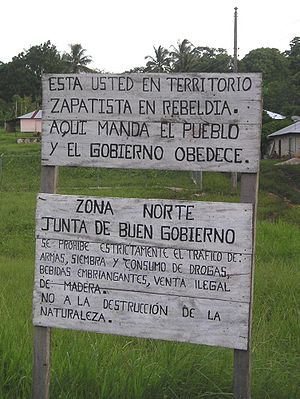- Councils of Good Government
-
Councils of Good Government were organized by the Zapatista Army of National Liberation (EZLN) guerrilla movement in their areas of influence (remote parts of the Mexican state of Chiapas).
 The sign reads (top): "You are in Zapatista rebel territory. Here the people give the orders and the government obeys." Bottom: "North Zone. Council of Good Government. Trafficking in weapons, planting of drugs, drug use, alcoholic beverages, and illegal sales of wood are strictly prohibited. No to the destruction of nature." Federal Highway 307, Chiapas.
The sign reads (top): "You are in Zapatista rebel territory. Here the people give the orders and the government obeys." Bottom: "North Zone. Council of Good Government. Trafficking in weapons, planting of drugs, drug use, alcoholic beverages, and illegal sales of wood are strictly prohibited. No to the destruction of nature." Federal Highway 307, Chiapas.
Contents
Background
In Chiapas, the Mexican Army was moved out of the zones of influence of the EZLN guerrilla movement as part of an unofficial truce. The EZLN organized autonomous municipalities based on the old indigenous custom of self-government. In these municipalities, an assembly of local representatives forms the Juntas de Buen Gobierno or Councils of Good Government (JBGs). These are not recognized by the federal or state governments; they oversee local community programs on food, health and education, as well as taxation.
History
During 2004 Subcomandante Marcos sent a series of communiqués across the globe in order to report on the Juntas de Buen Gobierno (or the Councils of Good Government), and the reflection of what the status of the Zapatistas is in relation to the world. The title Councils of Good Government is named in direct opposition to the "Bad" Government that these councils are set to counteract. There are a series of them across Chiapas, each one acting according to Zapatista guidelines but securing their own independent decisions and standards. The Juntas are not necessarily only accommodating of Zapatistas, but also of their supporters and allies.
The Councils of Good Government (or JBGs) also apply a rotation method of those who serve on the council. Each citizen within the jurisdiction of the JBG is required to serve on the council for two weeks, and then a new council is put into power. It is set up this way in order to secure that no political figures become corrupt or fall under the influence of outside forces. It also accommodates the needs, interests and concerns of each member within the area that the JBG covers.
The federal government ignores them, as they are few and located in remote parts of the state. Outside organizations that do interact with them find it difficult to do so, claiming their composition changes too quickly to maintain any knowledge of what is in progress.
Today
The Councils have created their own laws and enforce them, applying punishment when deemed necessary, under a community-based system. The JBGs have declared a serious stance against the trafficking of drugs and people. Various policing groups monitor the traveling of suspicious people and vehicles in order to prevent these things from occurring. The offenders are usually warned the first time, then punished if they repeat the offense, or turned over to the appropriate authorities if they are not Zapatistas. The people being smuggled are often deceived into thinking that they are going to be delivered to the United States, but often are abandoned to die by the smugglers. When these smugglers are caught the victims are taken care of by the JBGs, as well as given the money and goods that were being carried by the smuggler. The smuggler is then warned initially, but if caught again faces punishment if a Zapatista or is turned over to the authorities if not. Any drugs confiscated are destroyed, and the same system of punishment is applied. These claims, however, cannot be verified, since government representatives (bureaucrats, police and army members) avoid their zone of influence to preserve the unofficial truce on the EZLN guerrilla movement.
The Juntas of Buen Gobierno are overall succeeding[citation needed] in progressing towards implementing Zapatista ideology in their limited areas of influence.
See also
Categories:- Modern Mexico
- Secession in Mexico
- Zapatista Army of National Liberation
Wikimedia Foundation. 2010.
